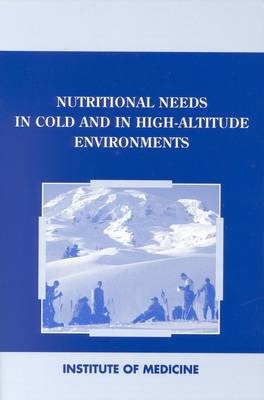
Nutritional Needs in Cold and High-Altitude Environments
National Academies Press (Verlag)
978-0-309-05484-3 (ISBN)
- Keine Verlagsinformationen verfügbar
- Artikel merken
This book reviews the research pertaining to nutrient requirements for working in cold or in high-altitude environments and states recommendations regarding the application of this information to military operational rations. It addresses whether, aside from increased energy demands, cold or high-altitude environments elicit an increased demand or requirement for specific nutrients, and whether performance in cold or high-altitude environments can be enhanced by the provision of increased amounts of specific nutrients.
Table of Contents
Front Matter
I: Committee Summary and Recommendations
1 A Review of the Physiology and Nutrition in Cold and in
High-Altitude Environments
2 Committee on Military Nutrition Research Recommendations and
Conclusions
II: Background and Introduction to theTopic
3 Cold Weather and High-Altitude Nutrition: Overview of the Issues
4 Leadership Insights for Military Operations in Cold Weather and
at High Altitudes
5 Cold-Weather Field Feeding: Military Rations
6 Feeding the US Army Sixth Infantry Division (Light) in the Cold
Part II Discussion
III: The Cold Environment
7 The Physiology of Cold Exposure
8 Military Schedules vs. Biological Clocks
9 Influence of Cold Stress on Human Fluid Balance
10 Muscle Metabolism and Shivering During Cold Stress
11 Macronutrient Requirements for Work in Cold Environments
12 Cold Exposure, Appetite, and Energy Balance
13 Effects of Cold and altitude on Vitamin and Mineral Requirements
14 Micronutrient Deficiency States and Thermoregulation in the Cold
15 Drug-Induced Delay of Hypothermia
Part III Discussion
IV: The High-Terrestrial Environment
16 The Physiology of High-Altitude Exposure
17 Physical Performance at High Altitudes
18 Fluid Metabolism at High Altitudes
19 Maintenance of Body Weight at High Altitudes: In Search of 500
kcal/day
20 Energy and Macronutrient Requirements for work at High Altitudes
21 Oxidative Stress at High Altitudes and Effects of Vitamin E
Part IV Discussion
V: Performance in Cold and in High-Altitude Environments
22 Effets of Altitue on Cognitive Performance and Mood States
23 Food Components and Other Treatments That May Enhance Mental
Performance at High Altitudes and in the Cold
General Discussion
Appendixes
A: Environmental Stress Management at High Altitudes by Adaptogens,
summary of unpublished manuscript
B: Biographical Sketches
C: Abbreviations
D: Factors Related to Nutritional Needs in Cold and in
High-Altitude Environments- A Selected Bibliography
Index
Bernadette M. Marriott and Sydne J. Carlson, Editors; Committee on Military Nutrition Research, Institute of Medicine
1 Front Matter; 2 I: Committee Summary and Recommendations; 3 1 A Review of the Physiology and Nutrition in Cold and in High-Altitude Environments; 4 2 Committee on Military Nutrition Research Recommendations and Conclusions; 5 II: Background and Introduction to theTopic; 6 3 Cold Weather and High-Altitude Nutrition: Overview of the Issues; 7 4 Leadership Insights for Military Operations in Cold Weather and at High Altitudes; 8 5 Cold-Weather Field Feeding: Military Rations; 9 6 Feeding the US Army Sixth Infantry Division (Light) in the Cold; 10 Part II Discussion; 11 III: The Cold Environment; 12 7 The Physiology of Cold Exposure; 13 8 Military Schedules vs. Biological Clocks; 14 9 Influence of Cold Stress on Human Fluid Balance; 15 10 Muscle Metabolism and Shivering During Cold Stress; 16 11 Macronutrient Requirements for Work in Cold Environments; 17 12 Cold Exposure, Appetite, and Energy Balance; 18 13 Effects of Cold and altitude on Vitamin and Mineral Requirements; 19 14 Micronutrient Deficiency States and Thermoregulation in the Cold; 20 15 Drug-Induced Delay of Hypothermia; 21 Part III Discussion; 22 IV: The High-Terrestrial Environment; 23 16 The Physiology of High-Altitude Exposure; 24 17 Physical Performance at High Altitudes; 25 18 Fluid Metabolism at High Altitudes; 26 19 Maintenance of Body Weight at High Altitudes: In Search of 500 kcal/day; 27 20 Energy and Macronutrient Requirements for work at High Altitudes; 28 21 Oxidative Stress at High Altitudes and Effects of Vitamin E; 29 Part IV Discussion; 30 V: Performance in Cold and in High-Altitude Environments; 31 22 Effets of Altitue on Cognitive Performance and Mood States; 32 23 Food Components and Other Treatments That May Enhance Mental Performance at High Altitudes and in the Cold; 33 General Discussion; 34 Appendixes; 35 A: Environmental Stress Management at High Altitudes by Adaptogens, summary of unpublished manuscript; 36 B: Biographical Sketches; 37 C: Abbreviations; 38 D: Factors Related to Nutritional Needs in Cold and in High-Altitude Environments- A Selected Bibliography; 39 Index
| Erscheint lt. Verlag | 15.6.1996 |
|---|---|
| Verlagsort | Washington |
| Sprache | englisch |
| Maße | 152 x 229 mm |
| Themenwelt | Sachbuch/Ratgeber ► Gesundheit / Leben / Psychologie ► Ernährung / Diät / Fasten |
| Sozialwissenschaften ► Politik / Verwaltung | |
| ISBN-10 | 0-309-05484-2 / 0309054842 |
| ISBN-13 | 978-0-309-05484-3 / 9780309054843 |
| Zustand | Neuware |
| Haben Sie eine Frage zum Produkt? |
aus dem Bereich


